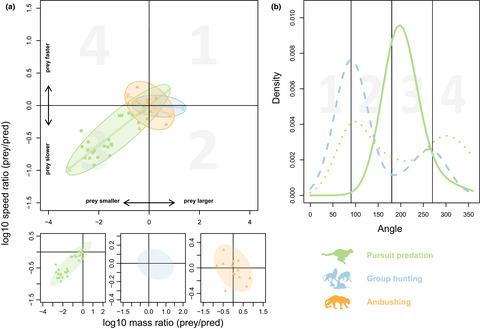当前位置:
X-MOL 学术
›
Ecol. Evol.
›
论文详情
Our official English website, www.x-mol.net, welcomes your feedback! (Note: you will need to create a separate account there.)
Rethinking trophic niches: Speed and body mass colimit prey space of mammalian predators.
Ecology and Evolution ( IF 2.6 ) Pub Date : 2020-06-28 , DOI: 10.1002/ece3.6411 Myriam R Hirt 1, 2 , Marlee Tucker 3, 4, 5 , Thomas Müller 3, 4 , Benjamin Rosenbaum 1, 2 , Ulrich Brose 1, 2
中文翻译:

重新思考营养小生境:速度和体重限制了哺乳动物捕食者的猎物空间。
更新日期:2020-07-30
Ecology and Evolution ( IF 2.6 ) Pub Date : 2020-06-28 , DOI: 10.1002/ece3.6411 Myriam R Hirt 1, 2 , Marlee Tucker 3, 4, 5 , Thomas Müller 3, 4 , Benjamin Rosenbaum 1, 2 , Ulrich Brose 1, 2
Affiliation

|
- Realized trophic niches of predators are often characterized along a one‐dimensional range in predator–prey body mass ratios. This prey range is constrained by an “energy limit” and a “subdue limit” toward small and large prey, respectively. Besides these body mass ratios, maximum speed is an additional key component in most predator–prey interactions.
- Here, we extend the concept of a one‐dimensional prey range to a two‐dimensional prey space by incorporating a hump‐shaped speed‐body mass relation. This new “speed limit” additionally constrains trophic niches of predators toward fast prey.
- To test this concept of two‐dimensional prey spaces for different hunting strategies (pursuit, group, and ambush predation), we synthesized data on 63 terrestrial mammalian predator–prey interactions, their body masses, and maximum speeds.
- We found that pursuit predators hunt smaller and slower prey, whereas group hunters focus on larger but mostly slower prey and ambushers are more flexible. Group hunters and ambushers have evolved different strategies to occupy a similar trophic niche that avoids competition with pursuit predators. Moreover, our concept suggests energetic optima of these hunting strategies along a body mass axis and thereby provides mechanistic explanations for why there are no small group hunters (referred to as “micro‐lions”) or mega‐carnivores (referred to as “mega‐cheetahs”).
- Our results demonstrate that advancing the concept of prey ranges to prey spaces by adding the new dimension of speed will foster a new and mechanistic understanding of predator trophic niches and improve our predictions of predator–prey interactions, food web structure, and ecosystem functions.
中文翻译:

重新思考营养小生境:速度和体重限制了哺乳动物捕食者的猎物空间。
- 捕食者实现的营养小生境通常在捕食者与猎物的体重比的一维范围内进行表征。该猎物范围分别受到朝向小猎物和大型猎物的“能量限制”和“制服限制”的约束。除了这些体重比率之外,最大速度是大多数食肉动物与猎物相互作用中的另一个关键组成部分。
- 在这里,我们通过合并一个驼峰形的速度体质量关系,将一维猎物范围的概念扩展到二维猎物空间。这个新的“速度极限”还限制了掠食者的营养小生境。
- 为了测试针对不同狩猎策略(追求,群体和伏击的捕食)的二维猎物空间的概念,我们合成了有关63种陆地哺乳动物捕食者-猎物相互作用,它们的体重和最大速度的数据。
- 我们发现追逐捕食者捕猎较小且较慢的猎物,而群体猎捕者则专注于较大但大多为较慢的猎物,而伏击者则更灵活。群体猎人和伏击者已经发展出不同的策略来占据类似的营养小生境,从而避免与追捕掠食者竞争。此外,我们的概念提出了沿着体重轴进行这些狩猎策略的能量优化,从而为为什么没有小群猎人(称为“小狮子”)或大型食肉动物(称为“大型食肉动物”)提供了机械解释。猎豹”)。
- 我们的结果表明,通过增加速度的新维度将猎物范围的概念推进到猎物空间中,将促进对食肉动物营养小生境的新的机械理解,并改善我们对食肉动物与猎物相互作用,食物网结构和生态系统功能的预测。



























 京公网安备 11010802027423号
京公网安备 11010802027423号